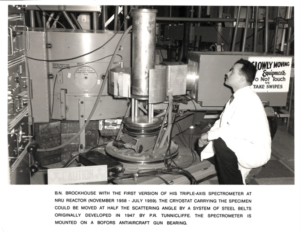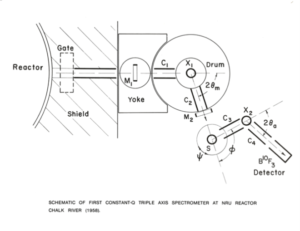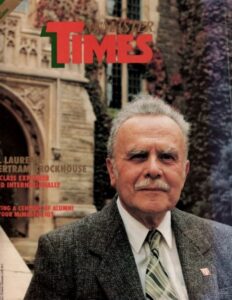Bertram N. Brockhouse

Bertram Neville Brockhouse was born in Lethbridge, Alberta on July 15th, 1918. His family moved to Vancouver, British Columbia, and then to Chicago, Illinois where he worked as a laboratory assistant at a small electronics firm after graduating from high school. An interest in the technical aspects of radios led Brockhouse to work as a self-employed radio repairman, both in Vancouver and Chicago.
Brockhouse worked as an electronics technician with the Royal Canadian Navy Volunteer Reserve during World War II. After being discharged, he attended the University of British Columbia where he obtained a degree in physics and mathematics. He received his master’s degree from the University of Toronto in 1948. In 1950, he received his PhD and submitted a thesis on “The Effect of Stress and Temperature upon the Magnetic Properties of Ferromagnetic Materials.” During this time, Brockhouse took a course on Nuclear Theory, which helped prepare him to work at the Chalk River Nuclear Laboratory, operated by Atomic Energy of Canada.
In collaboration with Myer Bloom and D.G. Hurst, Brockhouse’s first experiment at Chalk River studied the scattering of neutrons by highly absorbing elements. The apparatus for this work was later modified to study the inelastic scattering of several materials using absorption methods. Using the inelastic scattering of neutrons, he discovered the ability to reveal the movement of atoms in condensed matter. This discovery deepened scientists’ understanding of crystal structures and solids such as metals, minerals, and gems.


Brockhouse designed a triple-axis neutron spectrometer that earned him the Nobel Prize in Physics in 1994. This device revolutionized the ability to chart atomic dynamics and is still used today at neutron scattering centres around the world. The machine measures the frequency distribution of phonon excitations in crystals and carries out scans as a function of energy at fixed momentum transfer. This is known as the constant-Q technique. Today, triple-axis neutron spectrometers are used to study the structure of condensed matter in a variety of areas, from chemistry and medicine to metallurgy and nuclear power.
Using these new devices and techniques, Brockhouse and his colleagues were able to carry out many foundational measurements. His work measuring the alkali halides contributed to the development of the famed shell model of insulators.
 Brockhouse served as a Professor of Physics at McMaster University from 1962 until his retirement in 1984. He was also chairman of the Department of Physics from 1967 to 1970. Brockhouse used his position to share his enthusiasm for physics with undergraduate and graduate students. He also used the McMaster Nuclear Reactor to conduct preliminary work for experiments that would be performed at Chalk River. In 1995, the Institute for Materials research at McMaster was renamed The Brockhouse Institute for Materials Research in his honour.
Brockhouse served as a Professor of Physics at McMaster University from 1962 until his retirement in 1984. He was also chairman of the Department of Physics from 1967 to 1970. Brockhouse used his position to share his enthusiasm for physics with undergraduate and graduate students. He also used the McMaster Nuclear Reactor to conduct preliminary work for experiments that would be performed at Chalk River. In 1995, the Institute for Materials research at McMaster was renamed The Brockhouse Institute for Materials Research in his honour.
Brockhouse was an Officer of the Order of Canada and a Fellow of the Royal Societies of Canada and London. He received many honours, including the Centennial Medal of Canada and honorary D.Sc. degrees from the University of Waterloo and McMaster University.
Blog
